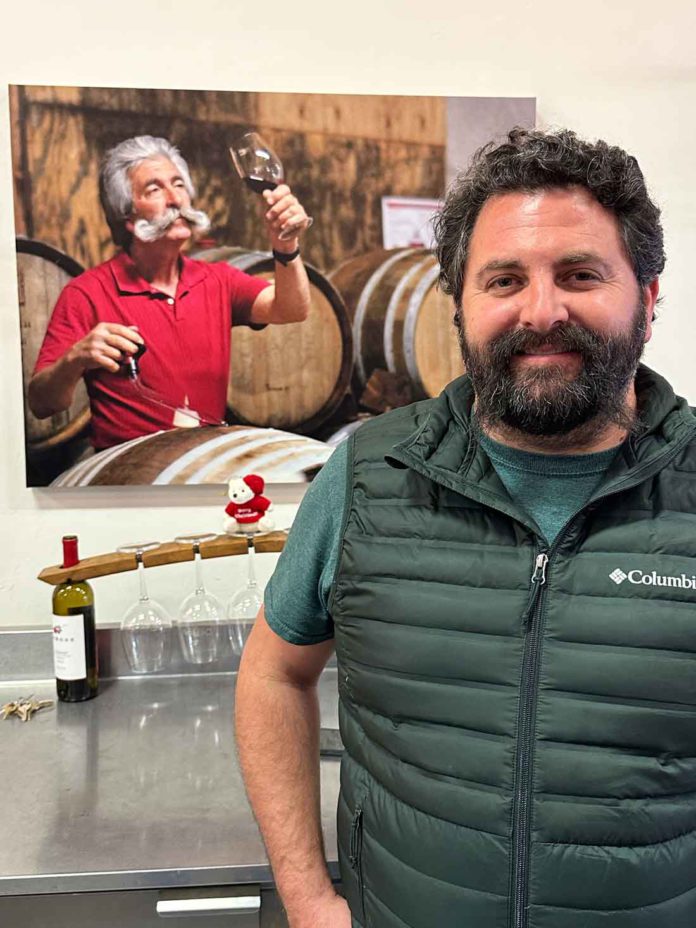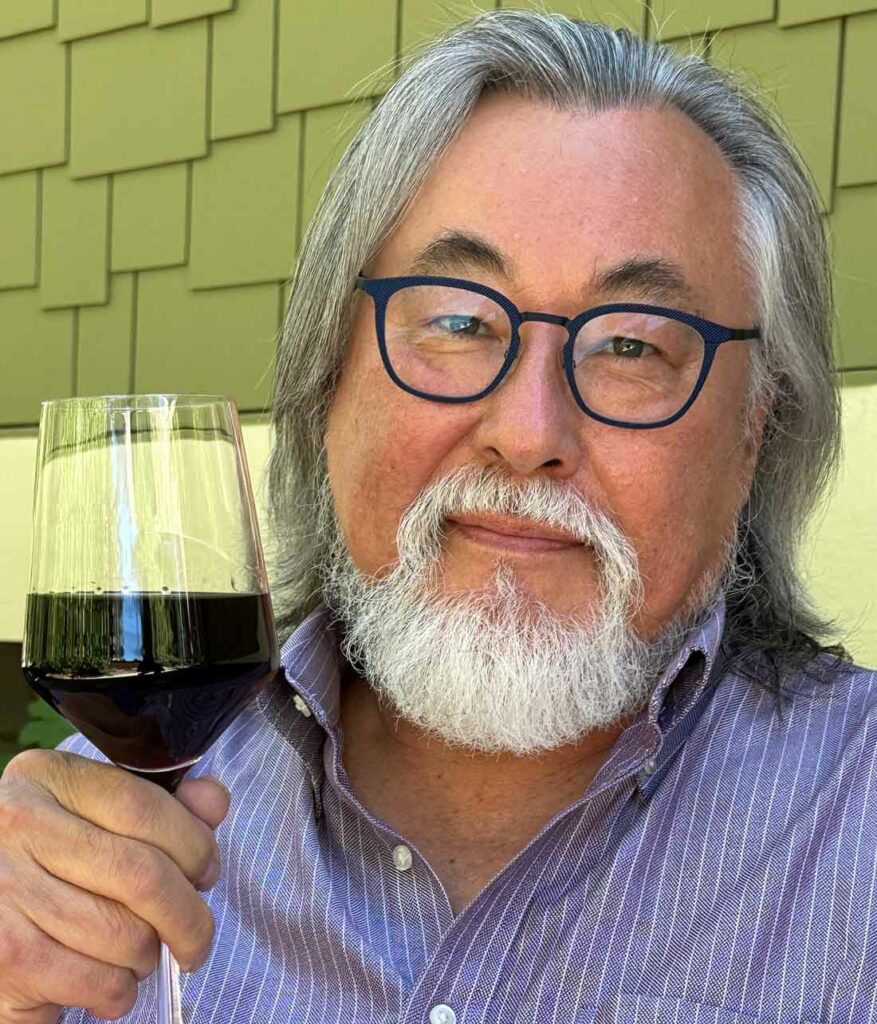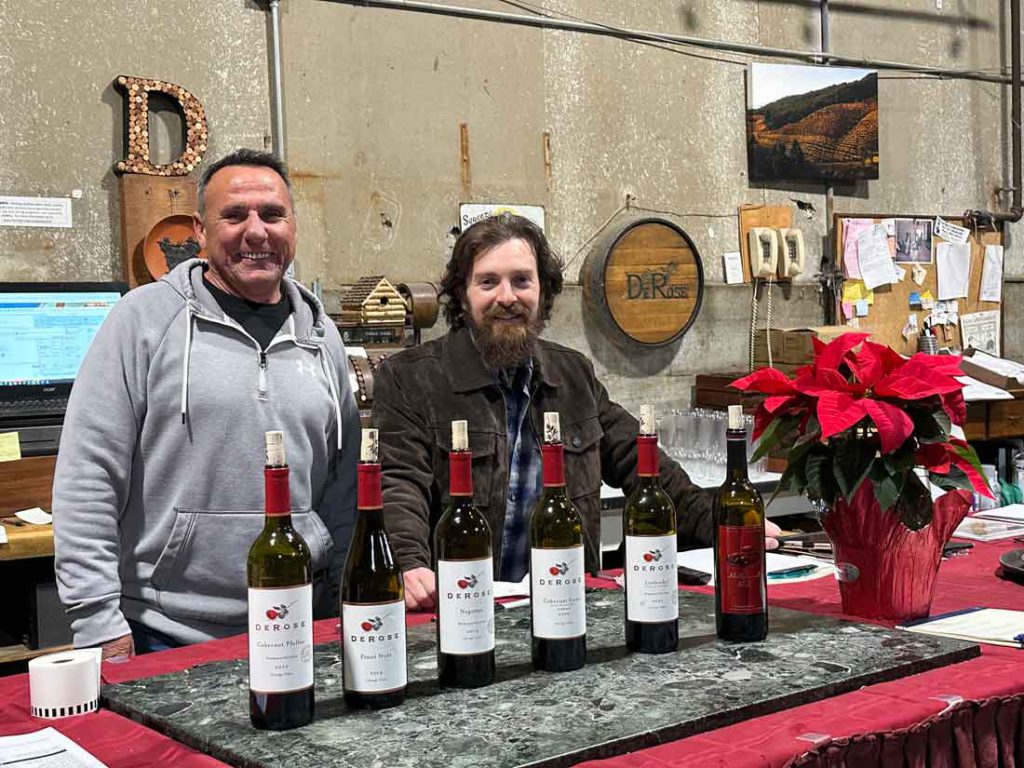
In my last column I highlighted Rosy and Rich Bergen’s Little Uvas Vineyard (LUV) and their facility called “The Garage” at 255 Fitzgerald Ave. in San Martin. Their long range plan is to have other businesses, like other wineries and eateries, help fill the facility and create a unique destination.
It didn’t take long before they had a new tenant in DeRose Vineyards who set up a tasting room inside one of the converted warehouses surrounded by Rich’s collection of cars.

DeRose Vineyards may have been new to The Garage but they are anything but new to the California wine scene. Founded in 1988, they introduced their first wines under the current label in 1993; but that’s far from the first time wine has rolled out of the winery at 9970 Cienega Road in Hollister that is now worked by the DeRose family.
The location we now call DeRose Vineyards is the oldest continuously producing vineyard in California. Originally founded in 1851 by Theophile Vache, the winery started selling his wines in 1854.
In 1880, a German immigrant named Willaim Palmtag purchased the vineyard from Theophile “just call me Theo” Vache. In 1900, Palmtag took his wines to the World Exposition in Paris, France where he won silver medals just over three quarters of a century before California wines burst onto the world’s premium wine stage at the 1976 Judgment of Paris. The famous blind tasting of wines by France’s premier wine experts put upstart California wines against some of the finest (read expensive) French wines of the time.
Californian wines dominated and won both of the red and white wine categories (watch the movie “Bottle Shock” for a fun depiction of this event). California had arrived—again!

Talking to Al DeRose and Tony DeRose, sons of Pat DeRose, I learned about their family history, which includes a couple generations of DeRose farming in the San Jose area and even more ancestors making wine before that in Italy.
They sold their last parcel of farmland in the San Jose area and invested in the current DeRose Vineyards location in 1988. At first, under the name Cienega Valley Winery, they produced large quantities of wine. By 1993, they turned to quality and not quantity, and the DeRose Vineyards name was born.
There were early partners, but it was patriarch Pat DeRose who learned the craft of making a quality wine; his son Al soon followed suit.
At first it wasn’t easy as over the years the dwindling production of previous owners like Almaden Vineyards and Hueblein Spirits allowed some old vines to get weed choked; the vineyards needed some TLC. At over 50 acres it was a chore but it has paid off.
Some of those old vines are still producing after 100 years and they are special.
On a positive note, what some of that neglect by the previous owners did was to create a vineyard that is truly “dry farmed.” Dry farming means there is no irrigation and the vines produce what they can given the water resources of the year, which then also greatly dictates the production volume for the year. True dry farming is relatively rare.
Another interesting factoid is the winery sits on two continental plates, a small part on the North American and the majority on the Pacific Plate. On a walk with Tony to the outdoor seating area I was shown a concrete ditch where you could actually see the effects of those two moving plates with about a three foot offset in one place. It’s one of those places that so dramatically shows the movement along a fault line it’s made it into geology books.
DeRose Vineyards’ outdoor seating area is a beautiful spot with a stage under the cover of a tree with tables looking out over the vineyard. I was fortunate enough to arrive on a sunny mid-December day where short sleeves and skirts were the norm (don’t you just love it?).
There is also an indoor tasting room, for those not so nice days, with an old oak aging barrel probably 15 feet tall and full of history and character. Inside the tasting room, you’ll also find racks of wine for sale and maps of other parts of the world, including Chile and Argentina, where wine is made.
Turns out these maps aren’t just for entertainment because there’s more to the son and winemaker Al DeRose. I had the great fortune of meeting Al at a small gathering at the home of Rosy and Rich Bergen the night they first tasted their LUV wines. Al was opening the bottles and we all tasted while he just recited what he was tasting—you know, those descriptions like “notes of citrus” or “tropical fruit” or “dried cherries”, etc. You know, all those things I can’t for the life of me taste until I’m led to them? This is why I don’t provide tasting notes of the wines—I can’t do it… but then most of us can’t so we just enjoy what we enjoy, right? Sorry, I digress…
So that night I learned that Al made all of the LUV wines except the Sauvignon Blanc, many of which would go on to win great awards.
I also learned that Al has had dozens more harvests under his belt than you could expect for such a young man. How do the number of harvests exceed your age? You make wine in North and South America.
He helps make wine in the U.S., Chile and Brazil, the latter of which gets two harvests per year due to their growing seasons. With four harvests per year in three countries you will soon get a lot of experience.

With father Pat now retired, and working on a car museum to open soon, Al is making the wines and they win awards too. DeRose specializes in red varietals with many being the prized old vine variety. The vast majority of their wines are estate; they source a little white wine from others but they even have their own old vine viognier.
With old vine Zinfandel, Syrah and Cab Pfeffer, among others, they have over 20 wines in their racks for sale. As an added bonus they make some incredible ports, which they can legally call port because they’ve been grandfathered in so they’re not called dessert wines (like Champagne not from the French region must be called sparkling wine).
With Al making the wines I had to ask him what is it that he’s most proud of, what would he want you to know about DeRose Vineyards.
He responded, “Quality is paramount and we make our wines the old world way. The farming is organic, you can even see the color of the soil has changed with this careful tending. The vineyards are dry farmed in addition to being organic so the environment wins too. We even use natural yeast in our winemaking.”
The wines are wonderful, the people are great, the Hollister venue is historic, and it’s all nearby. Fifteen minutes from downtown Hollister and you’re at the vineyard and fifteen minutes from downtown Morgan Hill and you’re in a fun tasting room.









